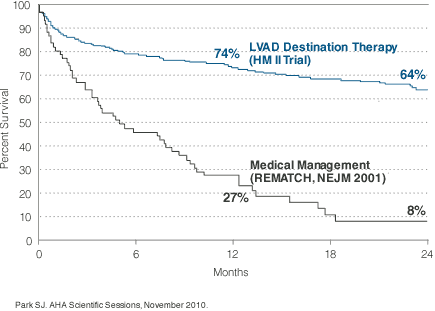LVAD Survival Compared to Optimal
Medical Management


2010 Annual Review
LVAD Survival Compared to Optimal
Medical Management

The initial HeartMate II DT clinical trial, published in 2009 in The New England Journal of Medicine, had already demonstrated that HeartMate II provides long-term survival greater than the earlier generation DT-approved device as well as previously reported outcomes with medical therapy alone.1, 2 Results have continued to improve, though, as was shown in late 2010 at the American Heart Association Scientific Sessions, where a key update from the HeartMate II Destination Therapy Continued Access Protocol (CAP) was presented. Survival for the CAP patients improved six percentage points at both 12 and 24 months relative to the early trial experience—to 74% percent survival at 12 months and 64% at 24 months.3
In addition, CAP patients experienced significant reductions in a number of key adverse events, including: >50% reduction in hemorrhagic stroke, >35% reduction in device related infections, and >25% reduction in sepsis. CAP patients also demonstrated considerable improvements in quality of life, with 85% classified as NYHA Class I or II patients at two years versus 78% of the primary trial cohort patients.3
1 Slaughter MS, Rogers JG, Milano CA, et al. Advanced heart failure treated with continuous-flow left ventricular assist device. N Engl J Med. 2009;361(23):2241–51.
2 Fang JC. Rise of the machines—left ventricular assist devices as permanent therapy for advanced heart failure. N Engl J Med. 2009;361(23):2282–84.
3 Park SJ. AHA Scientific Sessions, November 2010.